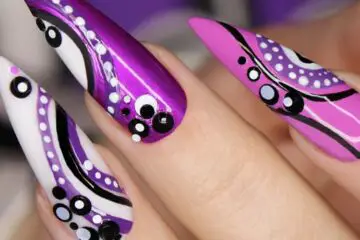Does a nail drill damage nails? | It’s a question many of us have probably asked ourselves at some point – does a nail drill damage our nails? After all, it’s a tool that is advertised to make our manicures look their best and last longer, but could it be damaging our nails in the process? Well, the answer might surprise you! Let’s take a look at how a nail drill works and what it really does to our nails. Read on for all the juicy details!
Do electric nail files damage your nails?
The short answer is no. A nail drill does not damage nails when used properly. In fact, it can actually help to protect them from harmful chemicals and environmental factors that can weaken the nail bed and make for a less than ideal manicure. A nail drill is designed to be gentle on the skin and nails, so you don’t have to worry about it causing any harm.
So, how does a nail drill work? Basically, it is a tool that uses electric or air-driven motors to rotate an abrasive bit at high speeds. This bit gently buffs away excess skin and cuticles around the nails to create a smooth surface for polish application. The best part is that the process is far less time consuming than filing by hand and you don’t have to worry about accidental damage like you would with traditional nail files.
Is it safe to use a nail drill?
Yes! Electric nail files are perfectly safe to use, as long as you are following the instructions and not pushing too hard. When using any type of electric nail tool it is important to use caution, such as wearing safety glasses to protect your eyes from flying particles and always unplugging the tool when it is not in use. Additionally, be sure to replace any worn or dull bits regularly.
When using a nail drill, it is important to be mindful of the speed you are working at. Depending on your experience level and the type of material you’re working with, high speeds can cause heat build-up and potentially damage delicate nails. Slower speeds typically give better control over the buffing process and help prevent over-buffing of the nail bed.
Finally, always remember to apply a nourishing cuticle oil after using an electric file as it can help keep your nails moisturized and protected from environmental factors that cause dryness and breakage.

Why does it burn when I use my nail drill?
When using an electric nail file, it is normal to experience a slight burning sensation on the skin surrounding your nails. This is due to friction created by the high speed motor and abrasive bit spinning against the nail bed. When this happens, it’s important to take a break from using the tool and allow your skin to cool down.
It’s also possible that the burning sensation you experience is a sign of over-buffing. If you feel like you are pushing too hard, or the bit seems to be dragging on your nail rather than moving in a circular motion, it could mean that you need to reduce the speed or replace the bit with one that has a stronger grit.
Also, be sure to avoid using any products that contain harsh chemicals, such as nail polish removers or acetone. These can cause irritation to the skin and nails, making them more sensitive to heat.
If you are still feeling discomfort while using your electric file, you may want to consider switching to a manual tool like a wooden nail file or buffer. Not only are these tools less abrasive, but they also provide better control over the buffing process.
Will using a nail drill weaken my nails?
No, using a nail drill should not weaken your nails. When used correctly, electric nail files can actually help to strengthen and protect them from damage. This is because the buffing action of the tool helps to remove ridges that can cause weak spots in the nail bed which can lead to breakage. The gentle pressure applied by the bit also helps to stimulate the growth of new and healthy nails.
However, it is important to remember that using an electric nail file too frequently can weaken your nails. This is especially true if you push too hard and over-buff the surface of your nails or cuticles. To avoid this, make sure to switch out any worn or dull bits regularly and adjust the speed as needed for different materials.
Additionally, be sure to apply a nourishing cuticle oil after each use to help keep your nails moisturized and protected.
Can a nail drill overheat?
Yes, electric nail drills can overheat if used incorrectly. This is usually caused by pushing too hard or using the tool at a very high speed for an extended period of time. This can cause the bit to become extremely hot and potentially burn the skin surrounding your nails.
How can I reduce nail dust?
Nail dust can be an unavoidable side effect of using a nail drill, but there are some steps you can take to minimize the amount of dust that is created.
The first step is to invest in a quality nail drill and replace any worn or dull bits regularly. Quality bits are designed to create less friction, which in turn produces less dust. Additionally, make sure you are using the correct bit for the material you’re working with.
The next step is to adjust the speed of your drill. Lower speeds generally create less dust than higher speeds, so start at the lowest setting and gradually increase as needed for different materials. It’s also important to maintain proper technique while using your electric file by keeping it moving in a circular motion rather than pressing down too hard on one spot. This will help prevent over-buffing and reduce heat build-up which can cause more dust particles to be released into the air.
Finally, it is important to wear a dust mask when working with your nail drill. This will help keep particles from entering your lungs and reduce the amount of dust in the salon. Plus, it’s a good practice to follow even if you aren’t using an electric file.
By taking these extra steps, you can help reduce the amount of nail dust created while using your electric file. Not only will this improve your work environment, but it will also provide better protection for both you and your clients.
Is it OK to file wet nails?
No, it is not OK to file wet nails. Filing wet nails can weaken the structure of the nail, leaving them prone to breakage and damage. This is because filing softens the outer layers of the nail which makes it easier for bits and files to tear away bits of keratin as you buff or shape your nails.
Also, filing wet nails can cause more heat build-up in the bit due to increased friction. This heat can be enough to cause discomfort or even burn your skin if you’re pressing too hard with your tool while filing.
For best results when using an electric file on natural nails, make sure that they are completely dry before beginning your work. It’s also important to reduce the speed of your drill when filing and make sure you’re using a quality bit that is sharp enough for the material you’re working with. Additionally, never press too hard on one spot as this can cause more heat build-up in the bit which can lead to discomfort.
If you’re working with artificial nails, it’s best to file them when they are slightly damp as this will make it easier to shape and buff the material. However, it’s important to avoid over-buffing artificial nails as this can damage the surface.
Overall, filing wet nails should be avoided whenever possible as it can weaken the structure of your natural nails or cause damage to artificial nail surfaces.
Conclusion | Does a nail drill damage nails?
This article discusses the effects of using an electric nail drill on natural and artificial nails. It explains that filing wet nails can weaken the structure of natural nails, while slightly damp artificial nails are best for buffing and shaping. It also outlines tips to help reduce dust created by the drill such as investing in a quality tool, adjusting speed settings, and wearing a dust mask. Lastly, it highlights some techniques to ensure that your work is safe and effective, including avoiding over-buffing and never pressing too hard with your tool.


